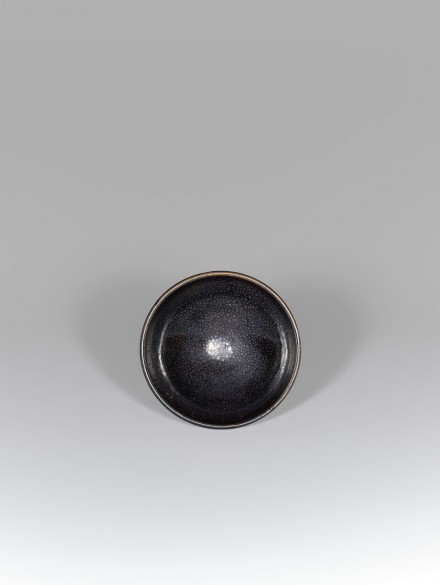J.J. Lally & Co., Oriental Art / New York City, New York
MenuPast Exhibition
The Gordon Collection:
Chinese Ceramics and Works of Art
March 12 - April 4, 2009

53.
AN ‘OIL-SPOT’ GLAZED SMALL BOWL
Jin Dynasty (A.D. 1115-1234)
With shallow rounded sides rising to a wide mouth with upturned rim, covered with a glossy black glaze with small circular silvery ‘oil-spot’ markings randomly distributed all over the surface, the glaze on the exterior ending well above the shallow ring foot with slightly splayed edge, the exposed stoneware showing a taupe-colored surface.
Diameter 4 1⁄8 inches (10.5 cm)
Two related ‘oil-spot’ bowls of this type from the Dane Collection were included in an exhibition at Harvard University in and illustrated by Mowry in the catalogue, Hare’s Fur, Tortoiseshell and Partridge Feathers: Chinese Brown- and Black-Glazed Ceramics, 400–1400, Cambridge, 1996, no. 43a & b, pp. 148-149, where the author notes that these bowls were the most famous product of the kilns at Xiaoyu cun, Huairen, Shanxi province. Mowry also provides a detailed description of the method used to achieve the ‘oil-spot’ effect by the addition of iron-rich solutions to produce iron compounds in the glaze which would crystallize on the surface during firing and thus give rise to the desired silvery ‘oil-spots.’
Compare also an ‘oil-spot’ bowl of very similar form and glaze in the Meiyintang Collection, Zurich, illustrated by Krahl, Chinese Ceramics from the Meiyintang Collection, Volume One, London, 1994, no. 472, p. 259. Another example from the Raphael Collection in the Fitzwilliam Museum, Cambridge University, England, is illustrated by B. Gray in Sung Porcelain and Stoneware, London, 1984, col. pl. I; and another very similar example is illustrated in the catalogue of the Turner Collection of Chinese Art, Eye to the East, Columbia Museum of Art, Columbia, South Carolina, 2008, p. 75.
A similar Northern ‘oil-spot’ teabowl of slightly larger size in the Museum of Fine Arts, Boston, is illustrated by J. Fontein and T. Wu, The World’s Great Collections: Oriental Ceramics, Vol. 10, Tokyo, 1980, pl. 170; and another slightly smaller ‘oil-spot’ bowl in the Tokyo National Museum is published in the Illustrated Catalogues of the Tokyo National Museum, Vol. I: Chinese Ceramics, Tokyo, 1988, no. 610, p. 152. A slightly smaller ‘oil-spot’ glazed bowl from the Millikin Collection in the Cleveland Museum of Art, is illustrated by Neils, The World of Ceramics: Masterpieces from the Cleveland Museum of Art, Cleveland, 1982, no. 113, p. 109, where the author notes that bowls of this type were highly prized by Zen monks and early tea ceremony masters in Japan, where they are referred to as ‘yuteki temmoku.’
金 黑釉油滴斑小碗 徑 10.5 厘米
53.
AN ‘OIL-SPOT’ GLAZED SMALL BOWL
Jin Dynasty (A.D. 1115-1234)
Diameter 4 1⁄8 inches (10.5 cm)